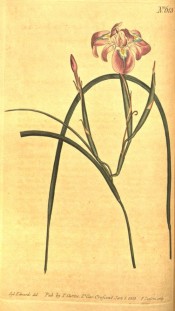Moraea fugax (D.Delaroche) Jacq.
Cormous perennial with a solitary, occasionally two, very long, wiry leaf below the inflorescence, and a stem, to 40cm, bearing up to 4, short lived, sweetly-scented, white, yellow or lilac flowers, with a bright yellow patch at the base of the outer segments, in late summer. The flowers open at mid-day, fading in the evening. [RHSD, CECB, Hortus, Grey].
Horticultural & Botanical History
The corms were in the past used for food, tasting like Spanish chestnut. ‘Flowers delightfully fragrant, varying exceedingly in size and in colour from a lilac to a deep blue, open in succession, and last about six hours each. […] An old denizen of the Dutch gardens.’ [BM t.613/1803]. Moraea edulis was introduced to Britain in 1792. [JD]. FS f.1058/1855-56. ABR pl.45/1799.
History at Camden Park
Listed in the 1850 and 1857 catalogues [B.325/1850].
Notes
Published Oct 19, 2009 - 05:08 PM | Last updated Jul 24, 2010 - 05:05 PM
| Family | Iridaceae |
|---|---|
| Category | |
| Region of origin | South Africa, Cape district |
| Synonyms |
|
| Common Name | Uintje |
| Name in the Camden Park Record | Moraea edulis |
| Confidence level | high |
